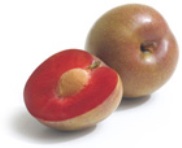|
Home Grown Fruit TreesNothing compares with the taste and flavor of home grown fruits. Freshly picked peaches at breakfast, an apple fresh from the tree at lunch, and a delicious pluot for desert after dinner and a late night fresh pomegranate - these can all be part of your healthy green lifestyle.
Growing your own fruit trees is really quite easy. Even if you don't have a yard, many dwarf varieties can be easily grown in a container on a sunny patio. Let's look at the basics of home grown fruit trees. -What varieties to plant -Where to plant them -Watering -Fertilizing -Pest Control -Pruning -Harvesting
What varieties to plantRemember, this is all about you - so start with what you like to eat and plant those fruit tree varieties. If you love peaches, plant peaches. If you don't particularly care for Apricots, skip them. Next, check out specific varieties to make sure they will grow in your area. Look at the "chilling requirements" - this is the number of hours below 45 degrees needed for that variety to set fruit. The warmer your climate, the lower the chilling hours. In other words, Houston gardeners need varieties with a lower chilling requirement than gardeners in Chicago. Check to see if the variety needs a pollinator. Some varieties require another tree in the general area to produce fruit, others do just fine on their own. Finally, look at the harvest time for each variety. If you are planting several peaches, choose varieties that ripen at different times so you can enjoy fresh peaches for a long period of time, and are not overwhelmed with more fruit than you can handle at one time.
Where to plant themFruit trees are quite adaptable and you can grow more fruit in less space than you might think. Some great tricks for maximizing your fruit production include planting 3 trees in the same hole. This works best with 3 trees of the same type (like 3 cherries, 3 peaches or 3 different plums). This is a great way to accommodate trees that need a pollinizer, or to enjoy an extended harvest season. Make sure you locate your trees in a spot that gets plenty of sun, and the soil drains. You do now want your trees sitting in water after a heavy rain. If you are limited on space, you can control the size of your fruit trees with summer pruning. This is really a better solution than planting semi dwarf trees which will usually grow larger than you want them to.
Watering
Be prepared to provide your trees water, especially if you live in an area with dry summers. If you allow the tree to get so dry it wilts, your fruit will suffer. Once established, infrequent deep soakings are much better than frequent shallow waterings. This can be a good place to use some of your grey water from the laundry room.
Learn more about water wise landscaping practices here
FertilizingIn order to produce an abundance of the best tasting fruit, your trees will need fertilizer. If you do a great job preparing the planting hole with plenty of organic matter like compost, you will minimize your need for fertilizer. I've had outstanding results with Fish emulsion (a bit smelly though) or cottonseed meal. You may also use any all purpose (has all 3 numbers, Nitrogen, Phosphorus, and Potassium). Feeding should be done at the beginning of spring in your area.
Pest Control
Your fruit trees will be attractive to a wide range of insect pests. The most important spraying of the year is your winter dormant spray. This is done during the winter while the trees are dormant with a light horticultural oil. This is very safe for people and pets and does not harm any of the beneficial insects. It will kill the overwintering larvae of many insect pests and will prevent many problems during the growing season. The oil is often mixed with a copper or sulfur compound to also help prevent diseases. During the growing season, you can use a mild solution of detergent and water to control aphids, and a great natural control for caterpillars is BT (Bacillus thuringiensis) which is sold under the names of Dipel and Thuricide. This is also safe for people, pets, and natural predators.
Pruning
Your fruit trees should be pruned twice a year. The winter pruning will thin out the growth, make sure plenty of light and air reaches the fruit producing branches, and shapes the tree. This will normally be a fairly severe pruning, especially with fast growing varieties like plums. Make sure you use sharp pruning shears, and always cut just above an outward facing bud. As long as your shears are sharp, don't worry about any type of pruning sealer - the cuts will heal by themselves just fine.
Harvesting
Now for the best part. Time to truly enjoy the fruits of your labor, your own home grown fresh fruit. The best way to harvest is to just harvest enough each day for what you will be using. Sometimes you seem to be battling the birds and squirrels to see who can harvest first (they will be equally impressed with your delicious healthy fruit). Some rubber snakes hanging in the tree make an effective deterrent if you move them every few days. Be sure to alert your family members about the rubber snakes in the fruit trees - especially if they are not snake fans!
That's all there is to it. Of all the pieces of Green Living, none is as satisfying and rewarding as being able to pick your own fresh healthy home grown fruit!
|

